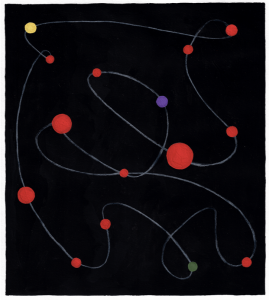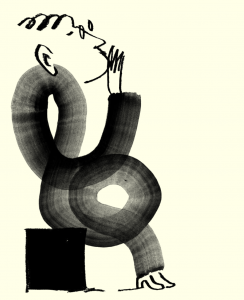
Is the visionary portrait photographer, and maverick aeronaut, getting the recognition he deserves? Adam Begley discusses
A recent French biography begins, “Qui ne connaît Nadar?” Who doesn’t know Nadar? In France, that’s a rhetorical question. In the rest of the world, hardly anybody knows Nadar – a pity, because he was one of the most compelling characters to stroll the gaslit boulevards of Baron Haussmann’s Paris. A tall, wild-eyed bohemian with a shock of red hair and a big, bristly mustache, he was born Gaspard-Félix Tournachon; Nadar was a pseudonym, a personal and professional brand name. He commissioned a red, illuminated version of his trademark signature, ten feet high and fifty feet long, and mounted iton the façade of the building where he plied his trade. And what was his profession? In the 1850s, he achieved a pinnacle of greatness with photographs of artists and writers and actors, most of them his friends. Whatever else he did—and he was at least as famous for his caricatures and his ballooning adventures as for his photography—one achievement will endure: Nadar did more than just about anyone to establish photographic portraiture as an art in its own right, psychologically penetrating and gorgeous to look at. He bequeathed to us a gallery of greats, from Baudelaire and Dumas to Sarah Bernhardt and Manet. By bringing us face to face with the geniuses of an earlier era, Nadar telescopes time: despite the sepia tint, the photos are as contemporary as Instagram.
His balloon flights turned him into a kind of action hero, his exploits shouted out by newspaper headlines worldwide. A brilliant publicist and self-publicist, in 1863 he built at vast expense what was at the time the world’s largest gas balloon, aptly named The Giant; its envelope, made of twenty-two thousand yard of scarlet silk, stood twelve stories high when inflated. This jumbo feat of self-promotion succeeded spectacularly even when it failed.
The Giant’s second flight began with pomp (the French Emperor attended the launch in Paris, accompanied by the King of Greece), and ended fourteen hours later with a horrific crash-landing near Hanover, Germany. The details, almost too hair-raising to believe, include a collision course with an express train and severed telegraph wires like “slashing razors” whipping at the gondola of the careening balloon, which bounced madly along the ground for more than ten miles at breakneck speed before smashing into a coppice where its catastrophic journey came to an end.
None of the six passengers was killed, though Nadar broke both legs and his young wife suffered an alarming wound to the neck. Telegraphed around the world, the incident created a sensation, with breathless reports in the Illustrated London News and The New York Times.
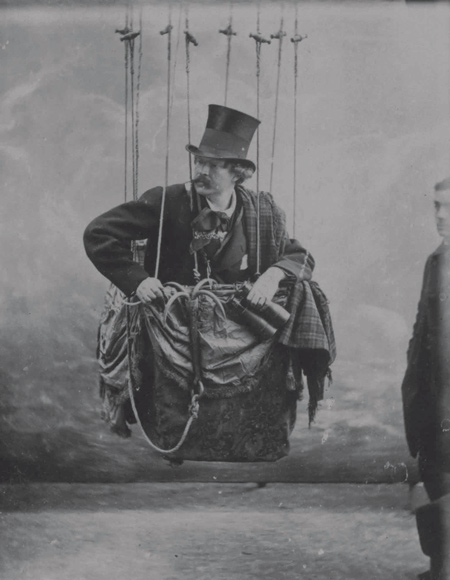
Nadar’s reaction was both surprising and typical. Much as he cherished the thrill of flying – the balloonist aloft, he wrote, “feels himself live as if for the first time” – he was convinced that gas balloons were destined for the slag heap. So he turned his fame as a daredevil “aeronaut” and the notorious wreck of his huge scarlet balloon into propaganda for the cause of heavier-than-air flight. He wrote a potboiler memoir, and resurrected The Giant, parading it here and there (and all the way to London); it served as Exhibit A in the case for a proposed “aero-locomotive,” distant forebear of Boeing and Airbus.
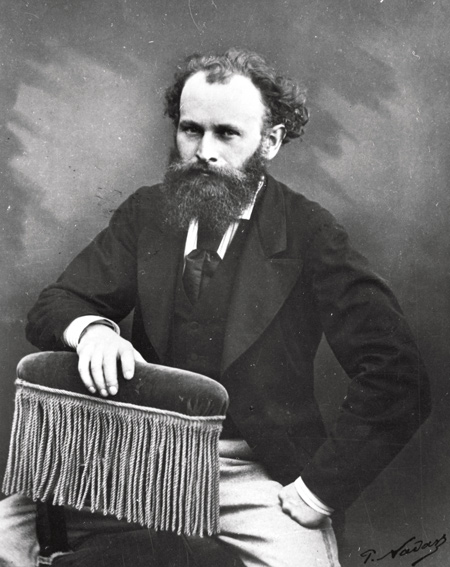
Flight, for Nadar, was always about perspective, about seeing from above, about seeing a long way. It was also about tantalising commercial prospects. He was the first person to take an aerial photograph—and registered a patent on October 23, 1858 for a device that would allow a balloonist “to employ photography for the production of topographical plans and cadastral surveys, and also for the direction of strategic military operations, for the erection of fortifications, and the disposition of armies on the march etc.” Talk about mercenary!
Isn’t there something quintessentially modern in the bizarre indirection and weirdly mixed motives of a man who crashes a balloon and publicises the disaster to promote another mode of flight? And how about a supremely accomplished artist whose instant reaction to his pioneering achievement as an aerial photographer is to cash in by selling his invention to estate agents, tax officials, and military brass? Needless to say, flying never made him rich—on the contrary, it sucked up income generated by his thriving photography studio. Nadar’s favorite expression, “Mais, quand même,” the rough equivalent of But all the same, can’t be translated exactly; my guess is that he meant something like a Gallic shrug accompanied by a cheerfully muttered What the fuck…
I’d like to make Nadar seem as fresh and alive as his portraits, but it’s hard to get past all the 19th-century trappings, the period facial hair and funny headgear. See him perched in a balloon basket in a photo from about 1865, hilariously staged in the studio: he strikes the pose of heroic nonchalance, a tartan throw over one shoulder, top hat and voluminous cravat proclaiming the dandified dignity of the dashing aeronaut. His gaze is studiously distant, as though he can see for miles, even without those impressive binoculars. Is it the future he’s looking at?
An inventor and innovator, Nadar was instinctively forward-thinking. He believed that “photography, electricity, and aeronautics” were the hallmarks of modernity, and ardently embraced all three. (Can anyone guess who pioneered photography by electric light? Our hero dramatized his invention by taking photos deep in the Paris catacombs.) All his life, Nadar was hungry for what comes next. Perhaps he would have been unable to imagine DNA sequencing or the gamut of wireless communication available in the 21st century, but you can bet he would have been an early subscriber to Snapchat.
Here’s what happened in September 1870 when Nadar found himself trapped by the Prussian siege of Paris. Even before the city was fully encircled, he established the “No. 1 Compagnie des Aerostatiers,” a corps of nine balloonists who made regular observational ascents, relaying their findings, marked in color-coded crayon on maps of the Paris region, to the military authorities. It was soon apparent to Nadar that these tethered ascents were of marginal utility, and that free-flight balloons were needed to break the complete communications blackout imposed by the Prussians.
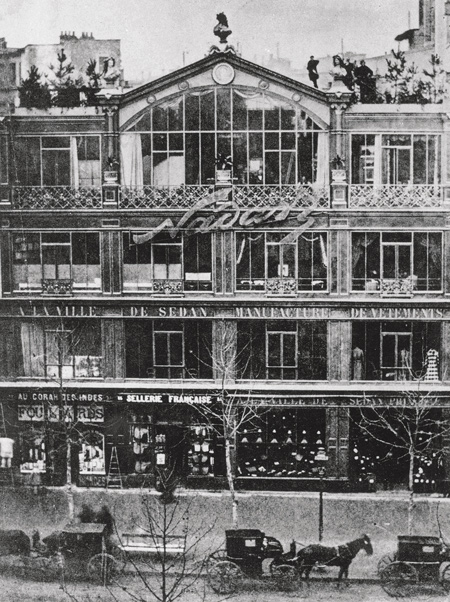
On September 23, the first siege balloon launched from the camp Nadar had established near Montmartre. It carried military dispatches and government paperwork – and, more importantly, over a hundred kilos of mail, the personal correspondence of ordinary Parisians otherwise cut off from the rest of the world. The balloon floated high above the Prussian army and drifted safely away to the southwest. As he passed over enemy lines, the aerostatier, a colleague named Duruof, threw out business cards marked “Nadar Photographe.” This inaugural flight was a tremendous propaganda coup for the French, and lifted the morale of the besieged capital – yet it left half the problem unsolved: mail could travel out of Paris, but not back in. One solution was carrier pigeons—but how much return mail can you stuff into the leg ring of your average pigeon? Sarah Bernhart is twenty years old and not yet famous in Nadar’s adoring portrait. Courtesy of Bridgeman Art Library
Once again, it was Nadar to the rescue. He latched onto the work of a fellow photographer, René Dagron, who conceived the brilliant idea of setting up a fixed camera and photographing hundreds of letters with a single exposure, then reducing the photo to a miniature negative. Grasping at once the significance of the process, Nadar introduced Dagron to the head of the Post Office and pitched the idea with eloquence and technical precision. In a matter of weeks, pigeons were carrying tens of thousands of letters on tiny rolls of collodion film back over the heads of the Prussians and home to roost on Paris rooftops—the first practical use of microfilm.
There’s no biography of Nadar in English; his writing (journalism, novels, memoirs) is untranslated, and in any case it’s more like the work of an exuberant hack than a true writer. Julian Barnes gives Nadar a supporting role in his latest book, Levels of Life, and the veteran biographer Richard Holmes has written about Nadar the balloonist in Falling Upwards: How We Took to the Air. There’s an excellent, fact-filled catalog, now out of print, of the mid-1990s exhibition of his work at the Musée d’Orsay and the Metropolitan Museum of Art. The best way to connect with him is to pore over his photographs, partly because it’s what he did best, and partly because photography is a medium still in flux and now more popular than ever. Nadar described it as a “fantastic discovery: a science which engages the most advanced intellects, and an art which provokes the most profound minds: and yet its use lies within the capacity of the shallowest idiot.”
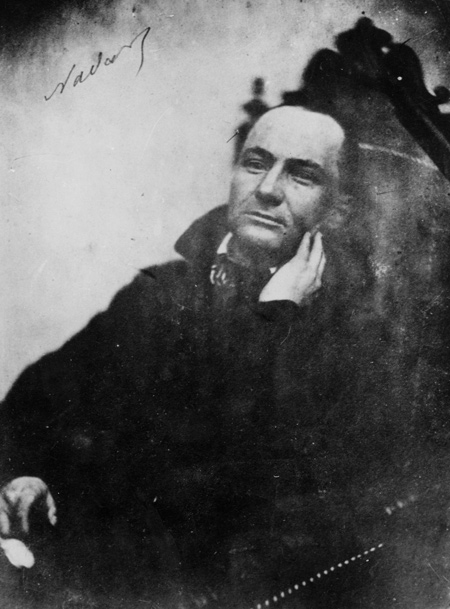
Look at the portrait of Manet, who died a hundred and thirty years ago, and tell me the intensity of the gaze isn’t that of a living painter, turning the tables and sizing up his next subject. Consider the vitality and determination of the fist planted on the thigh. The fragile curls on the balding head, the thick bristle of the beard, and the comic fringe on the velvet armrest do nothing to soften the steely aspect of a man intent on making art that will reach out and grab you.
Nadar’s talent for self-promotion, his distinctive personal style, his eagerness to capture the “moral nature” of his subjects—it all adds up, you would think, to a classic Romantic sensibility, complete with a premium on solitary genius, the individual artist’s unique sensibility. Nadar was certainly wacky and one-of-a-kind; the Romantic poet Gérard de Nerval, who famously used to walk his pet lobster in the gardens of the Palais Royal, introduced him thus: “This is Tournachon; he’s got lots of spirit, but he’s very crazy.” Yet Nadar was at crucial moments indifferent to the idea of individual artistic achievement. As a caricaturist, and again as a photographer, he established workshops that churned out, more or less under his supervision, collaborative work stamped with his trademark signature. (If Warhol’s Factory comes to mind, you won’t be surprised to learn that in 1999 the Getty Museum in Los Angeles organised an exhibition called Nadar/Warhol: Paris/New York.) Nadar’s only child, a son named Paul, worked closely with him for years before taking charge of the studio in the mid-1880s, perpetuating the family name. Nadar’s willingness to collaborate had his limits, however, as did his tolerance for his family. He sued his younger brother, also a photographer, to retain exclusive rights to the trademark Nadar – the first ever litigation in France over an artistic pseudonym.
However eager for profit, Nadar undoubtedly favored Art over Mammon. Consider the portrait of Baudelaire taken in 1855, at the very beginning of the photographer’s career. The poet reclines in a reverie, the pose verging on cliché. The pale, tentative hand raised to the cheek adds to the impression of a dreamy nature caught unawares. But isn’t there also a glint of the visionary, the artist as seer? The bold, composed features argue for strength; the cigarette in the right hand is a casual touch, a souvenir of bohemia. It’s a photo full of affection for the man (despite their occasional quarrels, they remained close friends for decades), and full of reverence for the poet.Nadar was a visionary, too, though his faith in progress now seems a rare old-fashioned attribute. He lived long enough to see prophecies fulfilled. In 1909, half a century after Nadar’s campaign in favor of heavier-than-air flight, Louis Blériot became the first man to cross the Channel in an airplane. The congratulatory telegram Nadar sent expresses his unflagging hope for a future in which he would play no part: “Moved by gratitude for the joy with which your triumph has just filled the antediluvian of ‘heavier than air’ before his eighty-nine years are underground.” He died eight months later, survived by his son, his trademark, and his magnificent photographs.
Words Adam Begley
